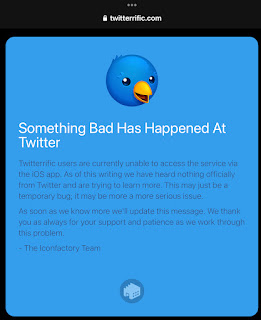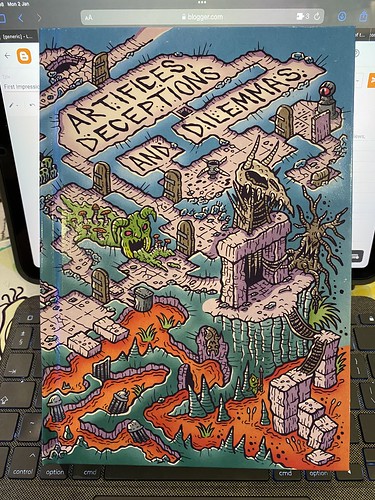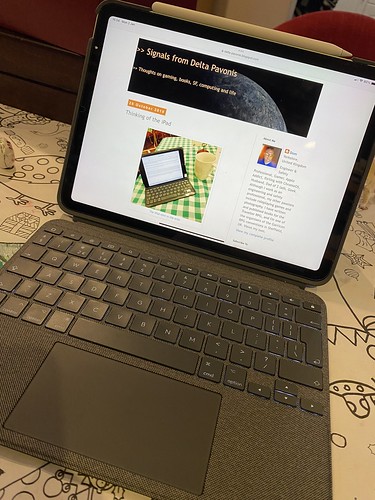 |
| Neon-Noir at its finest. |
Blade Runner: The Roleplaying Game has been one of Fria Ligan's most successful kickstarters and has been very much anticipated. That included myself as the original film is my all-time favourite SF-film.
I played the introductory adventure from the starter set over two slots at Furnace in October 2022 and I liked what I saw. The Core Rules are hardcover, 232 pages long and gloriously illustrated by Martin Grip who has absolutely nailed the vibe of the films. The book is full colour throughout and very dark. The level of illustration means that it isn't information dense, and it makes an easy read. It has multiple content warnings about the themes of the book, but hopefully you knew this if you've seen the movies.
The game engine uses an evolved version of the Year Zero Engine. Multiple dice sizes are used. Skills and Attributes are rated from A to D, where A is a D12 and D is a D6. In most cases, you roll a pair of dice. you're looking for 6+ (one success) or 10+ (two successes) on each dice. There is a push mechanic to try and increase your stress levels: you can't re-roll 1s, and on a push you get a point of damage or stress for every 1 showing, dependent upon the attributes being used. Replicants can push twice (representing their enhanced capabilities) but they don't take damage; everything is taken as stress. This means they're harder to hurt but mentally more fragile. Advantage and disadvantage is used; advantage adds a second dice of the same type as your lowest, disadvantage takes away the lowest. When helping, a character gives their colleague their skill base die to roll. Overall, the system feels slicker and less swingy than the base Year Zero Engine and characters feel more competent.
Characters are Nexus-9 replicants or humans assigned to the Replicant Detection Unit of the LAPD. They're built using archetypes tailored with skills. The archetypes are recognisable from the films and anime TV-series. Analysts, City Speakers, Doxies, Inspectors and more. They identify key attributes, skills and a speciality. Sample names and appearances are defined. You create key memories (which can help with stress) and relationships as part of the basic generation too. You get two derived characteristics to determine how much physical damage and mental stress your character can take; health and resolve. Replicants get a bonus to health and a penalty to resolve. They also get slightly higher attributes. If either of health or resolve is reduced to zero then you will be taking critical damage.
During the game you can gain or lose promotion points (which can help with specialities, salary and equipment) and humanity points (which can be used to raise skills). Replicants can gain humanity by failing a baseline test if their resolve is broken. However, fail too many and you could be retired.
There is a tight skill list (13); connections is the networking skill and should be useful for the genre. Driving is oddball; you don't use an attribute with this, rather you use the vehicle's manoeuvrability rating.
Specialities give you some extra bonus (for example a smoker can light up once per shift to recover stress, or someone who is married to the job can go for longer without needing downtime.
Combat uses the random cards deal for initiative, but on your turn you can chose to swap your card permanently with someone else and they cannot refuse. Otherwise it feels very similar to other Free League games. Overall, it's a fast system and the damage is pretty nasty if you take critical which happen when health zeros out and you're broken, or when you are hit with multiple successes. There's a nice chase mechanic; each turn the characters involved choose an action and the GM throws in a random event. The chase ends when characters catch up, shoot the runner in the back, or loose them in the distance. We played one of these at Furnace and it was fun and chaotic.
The book then describes the city, the tensions between the corporations and the UN, and between those who live below the hundredth floor and the rich. There's a decent map of the city and some nutshell descriptions of the areas in each sector. There's not a huge amount of information here; it's a framework to run your game around and I suspect that Alcon have deliberately kept it vague to avoid adding in canon. There's detailed discussion of the Wallace Corporation and the LAPD. Sections touch on off-world, crime and the press. Interestingly, the RDU is ambivalent about crime; it's not its purview and it may well turn a blind eye to get information on its own investigations. The RDU no longer has shoot-on-sight policies for replicants; there needs to be evidence and they are also there to protect replicants from abuse. A good portion of their funding and equipment comes from Wallace.
There's a good section on replicants; their history and how the Nexus-9 differs from the 6s and 8s that preceded them. The game also discusses the tensions between the Empathy Movement (anti-replicants) and the Sympathy Movement. The Replicant Underground who protected the Nexus-8s when they were banned was also discussed. Wallace is protective over replicants; the ban on their existance has only been lifted for a year, and they are very aware that bad publicity could prove fatal.
There's a lot of good information on working a case; where to get information, the resources available to the LAPD. This includes guidance on working a crime scene and details on the more unique equipment that Blade Runners can access. There's also a discussion on building your reputation or suffering disciplinary action!
The final section is all about running Blade Runner, starting with its key themes which are:
- Sci-Fi Action
- Character Drama
- Moral Conflict
- Corporate Intrigue
- Soul Searching
They each have a small paragraph but I think that this could have been developed a bit more than it is.
The section also discusses how to run the game; mood, pace and not being afraid to split the party. There is good advice on the use of handouts and also combat and chases to change the pace.
It then details the anatomy of a case file, a structure for the GM to prepare a case to investigate. The situation is presented, key locations and NPCs identified along with countdown of what will happen. Time is important in the game, with each day having four 6 hour shifts. You need to have downtime or you start to suffer stress. Downtime is discussed in detail and character's can have events happen related to their relationships, jobs and street life depending on how they're relaxing.
The text recommends to make sure that there are at least two different paths between each location in the game; it suggests using the RDU Deputy Chief Holden to feed information to the players if they become truly stumped, at the cost of a promotion point. However, much like Gumshoe, there's advice against hiding clues; this is about what they do with the information not how they find it.
There's a case file generator that seems good for inspiration. It gives you prompts for a theme, the assignment as briefed, NPCs encountered, locations, types of clues, twists, mood and the final confrontation. Conceptually, it's similar to the one in CY_BORG, so let's give it a go.
- Theme - Corporate Intrigue and Courtroom Drama
- Assignment - a lethal virus has been stolen from a high security lab and let loose in a run-down environment
- 5 key NPCs
- Entertainment, Actor, fast talker, Ariana Rodrigues
- Street, Store Owner, grubby clothes, Vladislav Ibrahim
- Science, Researcher, Tired, Reinhard Ricci
- Tech, Technician, Mumbling, Amar Mirai
- Science, Scholar, Bald, Ivana Meier
- Locations
- Sector 5 - Central, Little Tokyo Shopping District, Shinjuku Alley
- Sector 2 - Arts District, University of Los Angeles, Student Dorms
- Sector 5, LAPD HQ, Mainframe
- Clues
- Documents, ticket
- Witness (roll another NPC Politician, Overly Eager, Libby Wyman)
- Documents, ID card
- Recording, Photo
- Twist
- One of the PCs is framed for a crime
- Final Confrontation at Mansion outside the city in the pouring rain
- Mood example - heavy rain, sports event on screen, street sweeper passes
It's pretty good for getting some inspiration. I could build from this.
However, what I think the game does lack is some discussion about how you hang this together; the locations and NPCs will form a path to that final confrontation. City of Mist does this with the iceberg structure and clear advice. The Esoterrorists did it by starting with a spine and hanging clues off it to progress. Even though the GM is advised that the investigation isn't the point of the game, and that the challenging personal and moral dilemmas are, the investigation needs to hang together coherently with a clear set of paths through it and the countdown set against it. I think this is a miss, and may well make the game difficult for inexperienced GMs. That said, the GM section is good.
So what do I think about Blade Runner: The Roleplaying Game? It looks gorgeous. It's well written and coherent, strongly hitting the notes from its sources, although don't come to this looking for fresh background details. The framework for cases is solid, and the mechanics support the style of play well. It could have done with another two pages giving guidance on building the path through the investigation and advice on linking it back to the key themes. That aside, this is really well done and I recommend it.
5 January 2023






















